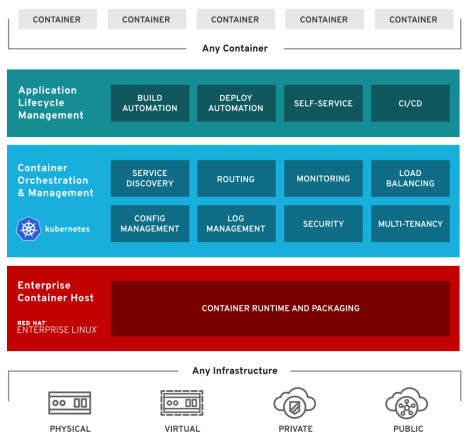Red Hat OpenShift is an enterprise-ready Kubernetes platform for deploying applications in hybrid cloud environments.
That’s the elevator pitch. A more in-depth description is that OpenShift has been designed to provide enterprises with the speed and power of cloud-based development—containers, microservices, CI/CD pipelines—on-premises and in the cloud.
It’s essentially one package with an array of tools to accelerate the development and deployment of new products—all with the support of Red Hat’s legendary engineering teams.
Under the hood
Dell EMC recently published a technical breakdown of OpenShift. But, for the purposes of this post, we’ll focus on what’s included in the platform, the Dell EMC Ready Architecture, and what the combination of the two allows an enterprise to do.
First, here’s a graphic of the system architecture from the solution brief:

While the foundation of OpenShift is Kubernetes, Red Hat has designed the platform in such a way as to incorporate a suite of software working in concert. This suite includes:
- Enterprise-grade Linux operating system.
- Container platform based on Kubernetes and Docker.
- Containerized and distributed storage for persistent volume storage and container registry.
- Built-in automation for resource provision, application deployment, and infrastructure configuration.
- Remote server administration.
By incorporating all these tools, Red Hat has created an out-of-the-box means for adopting Kubernetes regardless of where development takes place.
Download Now: Learn How To Build More Applications, Faster With Red Hat OpenShift
Dell EMC Ready Architecture
As detailed in the solution brief, Dell has worked with Red Hat on a series of hardware components to leverage the capabilities of OpenShift. These components are:
- Dell EMC PowerEdge R640 servers to manage three master nodes, three infrastructure nodes, four application nodes, and one basation node.
- Dell EMC PowerEdge R740xd servers for storage nodes.
- Dell EMC Networking S5248F-ON or S5232F-ON switches.
- Dell EMC Networking S3048-ON switch for management.
While usage of these components is not required, like the OpenShift platform itself, the Dell EMC Ready Architecture has been designed as a simple package for running and managing containers on-premises, in the cloud, or in a hybrid solution.

What OpenShift + Dell EMC + Redapt allows your enterprise to do
With the array of tools available via OpenShift and Dell hardware, Redapt integrates an out-of-the-box means for accelerating development and deployment cycles. Specifically:
- Application stacks on-demand so you can utilize the languages and tools you want and deploy through container images.
- Simplified deployment via a simple button click or git push command.
- Support for multiple environments—on-premises, the cloud, hybrid—along with automated release management.
Best of all, you’re able to achieve this acceleration without the need for an army of engineers, and your developers and operations teams can use the software stacks they’re most comfortable with regardless of where development is being done.
For more information on how you can utilize OpenShift to speed up how you develop and deliver new applications, download our free eBook, Build More Applications, Faster.
Categories
- Cloud Migration and Adoption
- Enterprise IT and Infrastructure
- Artificial Intelligence and Machine Learning
- Data Management and Analytics
- DevOps and Automation
- Cybersecurity and Compliance
- Application Modernization and Optimization
- Featured
- Managed Services & Cloud Cost Optimization
- News
- Workplace Modernization
- Tech We Like
- AWS
- Social Good News
- Cost Optimization
- Hybrid Cloud Strategy
- NVIDIA
- Application Development
- GPU








